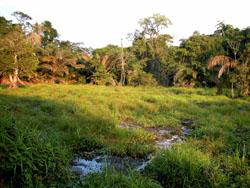
An example of landscape mosaic
in the Ivindo National Park, Gabon
© O. Hardy
Here, we will run the DVM without the dispersal module (i.e., assuming equilibrium with climate) for the present, the pre-industrial, and all planned snapshot paleosimulations. We will compare the results for all simulated species to niche-based modelling. The distributions of the focal tree species obtained for the Eemian and the Holocene will be compared. Combined with data from WP3, the results for the LGM will allow defining glacial forest refugia. A transient CARAIB DVM model simulation will be run over the Guineo-Congolian region from the LGM to pre-industrial time using, for a subset of the focal trees, the “dispersal module” previously developed. Probability of fires will also be examined.

 accès campus
accès campus
 bacheliers (liste des formations)
bacheliers (liste des formations)
 contacts
contacts
 formation continue
formation continue
 la recherche à l'ulb
la recherche à l'ulb
 musées de l'ULB
musées de l'ULB
 service communication
service communication
 actualités de l'ULB
actualités de l'ULB
 calendriers
calendriers
 documents officiels
documents officiels
 hôpitaux universitaires
hôpitaux universitaires
 les débats de l'ULB
les débats de l'ULB
 plan langues
plan langues
 soutenez l'ULB
soutenez l'ULB